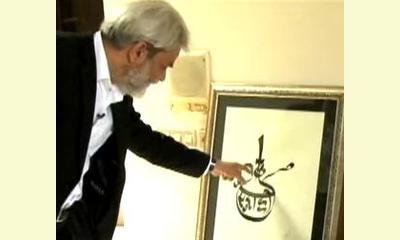|
|
Art for Peace and Collaboration --- Samrup Rachna
un articulo por Dr Syed Mohammed Anwer
Video: Syed Mohammed Anwer calligraphy
Samrup Rachna is a form of calligraphic art created by Dr Syed Mohammed Anwer to promote peace and collaboration in the South Asia region where Hindi-Urdu is spoken.

Syed Mohammed Anwer calligraphy
click on photo to enlarge
The name comes from the Sanskrit words Samrup (सामरुप) (سامروپ), meaning "congruence" or similar, and Rachna (रचना) (رچنا) meaning "creative work or design". The calligraphy is an attempt to use the two altogether different Devanagari and Nastaʿlīq script scripts, used by the same language Hindi -Urdu, in unison in such a manner that a picture of the word which is written is formed.
For example, the Hindi-Urdu word surahi (meaning "ewer" or "pitcher" in English) is written in Samrup Rachna calligraphy in Devanagri and Nastaʿlīq scripts of Hindi-Urdu in a way that a picture of a ewer is formed.
In linguistics, languagea which are written in two different scripts are called Synchronic digraphia. Hindi-Urdu is one such language.[11] Samrup Rachna is also advocated by its inventor to help readers of Nastaʿlīq (Urdu) script to understand and learn the Devanagari (Hindi) script of the same language. This art is aimed at helping to dispel the existing religious association with the two scripts in the region of South Asia. References may be found on Wikipedia.
Language has no religion its speaker may have one. Hindi-Urdu is the biggest common denominator between India and Pakistan . . . This art will help in promotion of peace tolerance understanding and collaboration between the people of these two countries and will help in reducing intolerance . . ..
|








|
DISCUSSION
Pregunta(s) relacionada(s) al artículo :
Artistic expression, Can it help us understand the values of other groups and peoples?
* * * * *
Comentario más reciente:
:
CPNN has received the following addition to the article about Samrup Rachna from its author, Dr Anwer
How common language and common values , common hoistry , common heritage and common collective behaviours of the people of South Asia ( India and Pakistan ) can be utilized to bring them closer to achive common goal of peace and prosparity . The effort to highligh these commonalities is explained in a lecture on his forth comming book by Dr Anwer titled " Apni Boli Apna Samj" our own language and culture .
Kuch Khaas: Calligraphic Expression of Apni-Boli
Highlighting the commonalities between India and Paksitan will bring the people closer ? Our Language ( Hindi-Urdu) and our Smaj ( Culture+Society+Traditions) are same then where is the the problem ?

|
|








